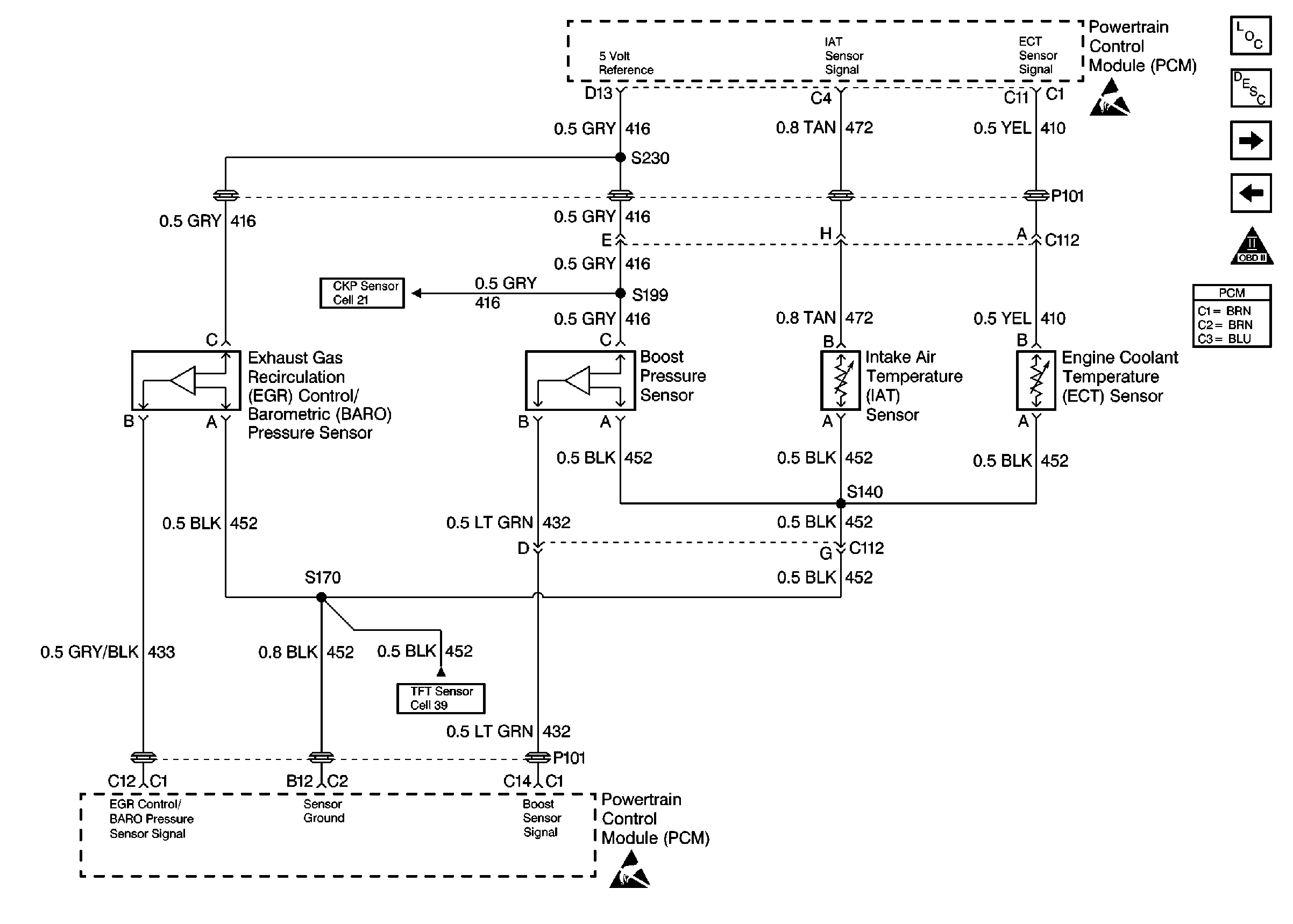Refer to
DIESEL PCM, EGR, SENSORS

Circuit Description
The powertrain control module (PCM) controls boost using the turbocharger wastegate solenoid. The solenoid is pulse width modulated (PWM). When the wastegate solenoid is not energized, the vacuum to the turbocharger wastegate solenoid is vented to atmosphere through the solenoid. As the pulse width is increased by the PCM, more vacuum is applied through the solenoid to the wastegate actuator. At idle a higher vacuum to the wastegate actuator helps keep the wastegate closed. At higher engine speeds the vacuum supplied by the solenoid is less, allowing the turbocharger boost pressure to overcome the wastegate actuator.
Conditions for Setting the DTC
| • | Boost Pressure less than 40 kPa. |
| • | Condition met for 2 seconds. |
Action Taken When the DTC Sets
The MIL will be illuminated after 2 test failures.
Conditions for Clearing the MIL/DTC
| • | The PCM will turn the MIL off after three consecutive trips without a fault condition. |
| • | A History DTC will clear when forty consecutive warm-up cycles that the diagnostic does not fail (coolant temperature has risen 5°C (40°F) from start up coolant temperature and engine coolant temperature exceeds 71°C (160°F) that same ignition cycle. |
| • | Use of a Scan Tool |
Diagnostic Aids
Very little boost can be attained by revving the engine in neutral. If the Boost sensor signal circuit is open or shorted to ground, Boost solenoid will show a zero duty cycle. A
An intermittent may be caused by the following:
| • | Poor connections. |
| • | Rubbed through wire insulation. |
| • | Broken wire inside the insulation. |
Test Description
Number(s) below refer to the step number(s) on the Diagnostic Table.
-
This step will determine if DTC P0237 is the result of a hard failure or an intermittent condition.
-
This step simulates conditions for a DTC P0237. If the PCM recognizes the change, the PCM and signal circuit are OK.
-
In this step, components that share the 5 volt reference can cause the reference voltage to be shorted to ground. This can be checked by disconnecting each component that shares the 5 volt reference one at a time, including the PCM while checking for continuity on that circuit to chassis ground.
Step | Action | Value(s) | Yes | No | ||||
|---|---|---|---|---|---|---|---|---|
1 |
Important: Before clearing DTCs use the scan tool Capture Info to record freeze frame and failure records for reference, as data will be lost when Clear Info function is used. Was the Powertrain On-Board Diagnostic (OBD) system check performed? | -- | ||||||
Does the scan tool display a Boost Pressure less than or equal to the specified value? | 40 kPa | |||||||
Does the scan tool display a Boost Pressure greater than or equal to the specified value? | 202 kPa | |||||||
4 |
Does the scan tool display a Boost Pressure greater than or equal to the specified value? | 202 kPa | ||||||
5 | The DTC is intermittent. If no additional DTCs are stored, refer to Diagnostic Aids. If additional DTCs are stored, refer to those table(s) first. Are any additional DTCs stored? | -- | Go to the Applicable DTC Table | Go to Diagnostic Aids | ||||
6 |
Was a problem found? | -- | ||||||
7 |
Was a problem found? | -- | ||||||
8 |
Was a problem found? | -- | ||||||
Was a problem found? | -- | |||||||
10 | Replace the Boost sensor. Refer to Boost Sensor (Diesel) . Is the action complete? | -- | -- | |||||
11 |
Was a problem found? | -- | ||||||
12 | Replace the PCM. Important: The new PCM must be programmed. Refer to Powertrain Control Module Replacement/Programming . Is the action complete? | -- | -- | |||||
13 |
Does the Scan Tool indicate that this diagnostic Passed? | -- | ||||||
14 | Using the Scan Tool, select Capture Info, Review Info. Are any DTCs displayed that have not been diagnosed? | -- | Go to the Applicable DTC Table | System OK |
